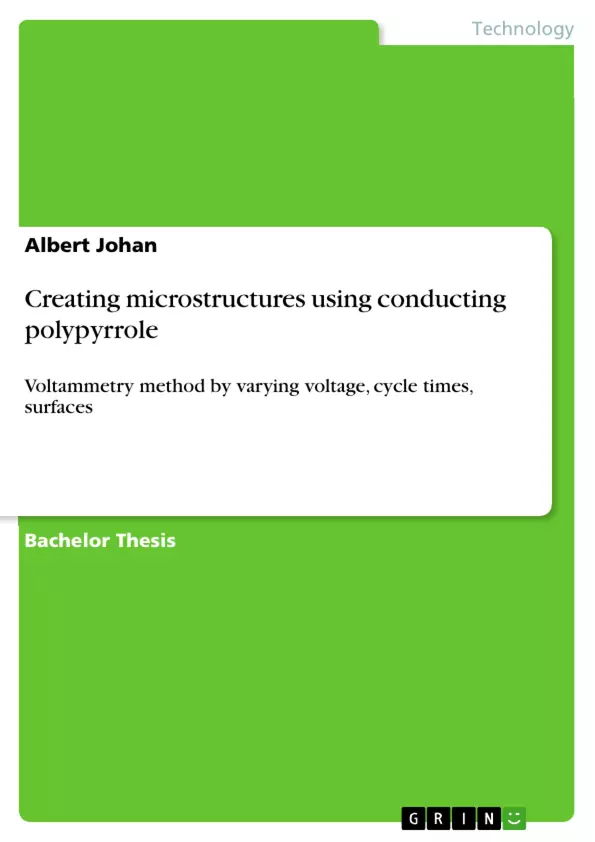Simple electrochemical aided polymerization was done using pyrrole and beta-napthalenesulfonic acid as electrolyte cum anionic surfactant to attempt creating microstructures on sputtered gold surface, highly oriented pyrolitic graphite, and thiol-modified gold surface. Hydrogen bubble template was used on gold, but results showed doubted polymerisation around this. Instead, one tenth structure size of hydrogen bubbles was commonly observed in two different electrolyte concentrations. No interesting
microstructure was formed on highly oriented pyrolitic graphite. This was due to polarisation of large size graphite. Irregular microcapsules were formed around n-decane template on thiol-coated gold, but other structures also appeared. Lack of control on many variables due to limitation of equipments and materials lead to inaccuracy and inability to do more detailed observation. However, some results showed research aim was achieved
Inhaltsverzeichnis (Table of Contents)
- Abstract
- Introduction
- Literature Review
- Experimental Section
- Methods
- Set-up
- Conditions
- Materials
- Schematic diagram
- Results and Discussion
- Gold surface stability
- Electropolymerisation of pyrrole around hydrogen bubble template on bare gold surface
- Surface hydrophobicity
- Electropolymerisation of pyrrole around n-decane droplet template on highly oriented pyrolitic graphite
- Electropolymerisation of pyrrole around n-decane droplet template on thiol-coated gold
- Conclusion
- References
Zielsetzung und Themenschwerpunkte (Objectives and Key Themes)
This research project aims to investigate the fabrication of microcontainers using polypyrrole through a simple electrochemical method. The study focuses on electropolymerizing pyrrole around hydrogen bubble templates formed on gold surfaces and around n-decane templates on highly oriented pyrolitic graphite and thiol-coated gold surfaces. The research also aims to identify the relationships between polymerization conditions and the resulting microcontainer shapes.
- Fabrication of microcontainers using polypyrrole through electrochemical polymerization
- Investigation of electropolymerization around hydrogen bubble templates on gold surfaces
- Exploration of electropolymerization around n-decane templates on different substrates
- Understanding the influence of polymerization conditions on microcontainer morphology
- Analysis of the suitability of various electrode materials for microcontainer formation
Zusammenfassung der Kapitel (Chapter Summaries)
- Abstract: This chapter provides a concise overview of the research project, highlighting the use of electrochemical polymerization of pyrrole to create microstructures on different substrates. It summarizes the main findings and challenges encountered during the study.
- Introduction: This chapter sets the context for the research by discussing the growing interest in fabricating microstructures of conducting polymers and outlining the specific research objectives. It identifies gaps in existing research related to the formation of microcontainers using polypyrrole, particularly on gold and highly oriented pyrolitic graphite substrates and around oil-droplet templates.
- Literature Review: This chapter reviews relevant literature concerning the fabrication of microstructures using simple electrochemical methods, focusing on the use of polypyrrole and various templating methods. It discusses the importance of considering factors such as electrode materials, electrochemical conditions, and hydrophobicity in achieving desired microstructures. The chapter also highlights conflicting and inconsistent evidence found in previous studies and identifies gaps in existing research regarding microcontainer formation on certain substrates and using specific templates.
- Experimental Section: This section details the materials and methods used in the study, including information on the electrochemical setup, materials, and experimental conditions. It provides a comprehensive description of the experimental procedures used to achieve the research objectives.
- Results and Discussion: This chapter presents the findings of the research, including the results of electropolymerization around hydrogen bubble templates on gold surfaces and around n-decane templates on different substrates. It analyzes the effects of varying experimental parameters on the resulting microstructures.
Schlüsselwörter (Keywords)
This research project focuses on the electrochemical fabrication of microcontainers using polypyrrole, utilizing hydrogen bubble and n-decane templates on gold, highly oriented pyrolitic graphite, and thiol-coated gold surfaces. Key themes include electropolymerization, microcontainer morphology, electrode materials, surface hydrophobicity, and the impact of experimental conditions on microcontainer formation.
- Citar trabajo
- Albert Johan (Autor), 2010, Creating microstructures using conducting polypyrrole, Múnich, GRIN Verlag, https://www.grin.com/document/506250



